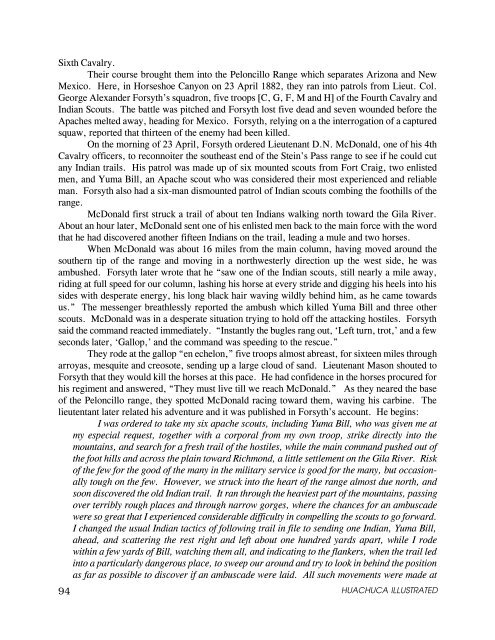Apache Campaigns - Fort Huachuca - U.S. Army
Apache Campaigns - Fort Huachuca - U.S. Army
Apache Campaigns - Fort Huachuca - U.S. Army
You also want an ePaper? Increase the reach of your titles
YUMPU automatically turns print PDFs into web optimized ePapers that Google loves.
Sixth Cavalry.<br />
Their course brought them into the Peloncillo Range which separates Arizona and New<br />
Mexico. Here, in Horseshoe Canyon on 23 April 1882, they ran into patrols from Lieut. Col.<br />
George Alexander Forsyth’s squadron, five troops [C, G, F, M and H] of the Fourth Cavalry and<br />
Indian Scouts. The battle was pitched and Forsyth lost five dead and seven wounded before the<br />
<strong>Apache</strong>s melted away, heading for Mexico. Forsyth, relying on a the interrogation of a captured<br />
squaw, reported that thirteen of the enemy had been killed.<br />
On the morning of 23 April, Forsyth ordered Lieutenant D.N. McDonald, one of his 4th<br />
Cavalry officers, to reconnoiter the southeast end of the Stein’s Pass range to see if he could cut<br />
any Indian trails. His patrol was made up of six mounted scouts from <strong>Fort</strong> Craig, two enlisted<br />
men, and Yuma Bill, an <strong>Apache</strong> scout who was considered their most experienced and reliable<br />
man. Forsyth also had a six-man dismounted patrol of Indian scouts combing the foothills of the<br />
range.<br />
McDonald first struck a trail of about ten Indians walking north toward the Gila River.<br />
About an hour later, McDonald sent one of his enlisted men back to the main force with the word<br />
that he had discovered another fifteen Indians on the trail, leading a mule and two horses.<br />
When McDonald was about 16 miles from the main column, having moved around the<br />
southern tip of the range and moving in a northwesterly direction up the west side, he was<br />
ambushed. Forsyth later wrote that he “saw one of the Indian scouts, still nearly a mile away,<br />
riding at full speed for our column, lashing his horse at every stride and digging his heels into his<br />
sides with desperate energy, his long black hair waving wildly behind him, as he came towards<br />
us.” The messenger breathlessly reported the ambush which killed Yuma Bill and three other<br />
scouts. McDonald was in a desperate situation trying to hold off the attacking hostiles. Forsyth<br />
said the command reacted immediately. “Instantly the bugles rang out, ‘Left turn, trot,’ and a few<br />
seconds later, ‘Gallop,’ and the command was speeding to the rescue.”<br />
They rode at the gallop “en echelon,” five troops almost abreast, for sixteen miles through<br />
arroyas, mesquite and creosote, sending up a large cloud of sand. Lieutenant Mason shouted to<br />
Forsyth that they would kill the horses at this pace. He had confidence in the horses procured for<br />
his regiment and answered, “They must live till we reach McDonald.” As they neared the base<br />
of the Peloncillo range, they spotted McDonald racing toward them, waving his carbine. The<br />
lieutentant later related his adventure and it was published in Forsyth’s account. He begins:<br />
I was ordered to take my six apache scouts, including Yuma Bill, who was given me at<br />
my especial request, together with a corporal from my own troop, strike directly into the<br />
mountains, and search for a fresh trail of the hostiles, while the main command pushed out of<br />
the foot hills and across the plain toward Richmond, a little settlement on the Gila River. Risk<br />
of the few for the good of the many in the military service is good for the many, but occasionally<br />
tough on the few. However, we struck into the heart of the range almost due north, and<br />
soon discovered the old Indian trail. It ran through the heaviest part of the mountains, passing<br />
over terribly rough places and through narrow gorges, where the chances for an ambuscade<br />
were so great that I experienced considerable difficulty in compelling the scouts to go forward.<br />
I changed the usual Indian tactics of following trail in file to sending one Indian, Yuma Bill,<br />
ahead, and scattering the rest right and left about one hundred yards apart, while I rode<br />
within a few yards of Bill, watching them all, and indicating to the flankers, when the trail led<br />
into a particularly dangerous place, to sweep our around and try to look in behind the position<br />
as far as possible to discover if an ambuscade were laid. All such movements were made at<br />
94<br />
HUACHUCA ILLUSTRATED

















